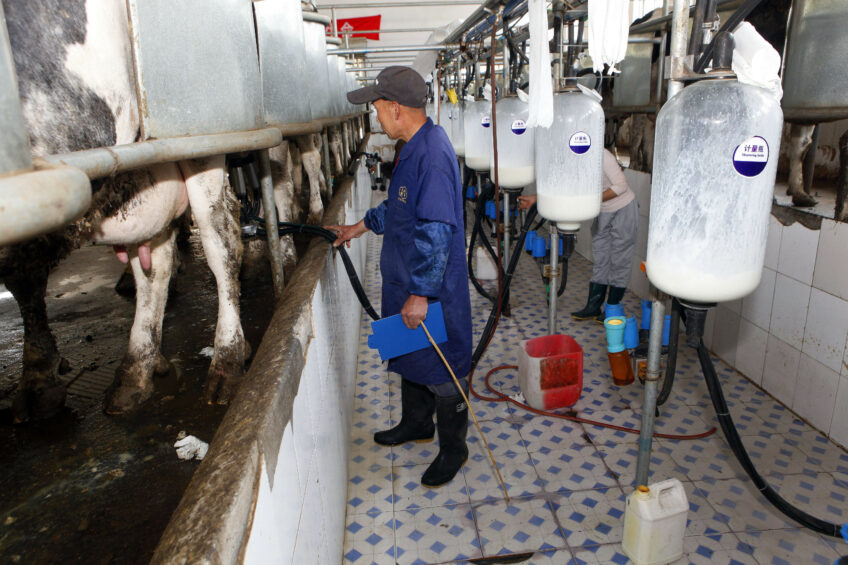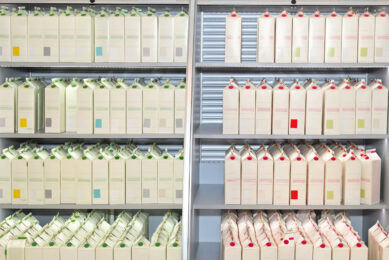Great potential, but China needs to step up quality

Continued growth for dairy products in China isn’t a given. An important factor to keep on growing is regaining public trust and improving milk quality. Two aspects that go hand in hand.
In China, dairy is said to be one of the fastest growing food and beverage sectors. With that said, according to Kantar Worldpanel research, a global expert in consumer behaviour, the average Chinese urban household purchases just one-fifth of what the average urban European household does in a year. Furthermore, two-thirds of what they do consume is imported, mostly from the European Union.
There is no local food movement in China, especially when it comes to dairy products. Instead, scepticism regarding food safety and quality standards drives Chinese consumers to make their purchases from what they consider more reputable online shopping sites. On a recent visit to China, Dairy Global saw first-hand the challenges, and the opportunities, that lie ahead for China’s quickly growing dairy sector.
Increase in large-scale farms
In 2015, of the approximately 2.65 million tonnes in sales, 1.79 million tonnes, or 68%, of China’s dairy products were imported, mostly from the EU. While consumption isn’t high by global standards, it is on the rise. Chinese producers hope to be able to support that growth locally. This growth is being supported by a change in agricultural policy at the government level, which helps support the development of larger farms, explained William Smits, director of farm management service for DeLaval, East Asia region. Over time, Smits expects to see small and middle-sized farms either consolidate or disappear altogether. The trend certainly supports that hypothesis. In fact, since 2008, large-scale farms in China have increase by 28% and 60% of milk produced in the country comes from those large operations.
Milk quality still an issue
Continued growth isn’t a given, though. On a recent visit to DeLaval (Tianjin) in Beijing, Smits was clear that China has a long way to go. Probably the country’s biggest issue is milk quality and concerns over food safety. Milk quality, said Smits, starts with feed, but Chinese producers still struggle with efficient grain production. They face soil and harvest contamination, as well as storage spoilage. They also struggle with zoonotic and udder diseases, and bacterial contamination. Much has improved since the melamine scare of 2008. Today, more milk is tested for SCC, dilution, antibiotics and additives, said Smits. Often, too, milk prices are linked to milk quality. As a result, disease outbreaks have been reduced, and fat and protein levels have increased. Today, more milk is rejected if it does not meet milk quality standards. As a result, many poor quality producers have left the industry entirely, said Smits.
Consumer confidence
Despite improvement and growth, Smits was clear that China still faces many obstacles. Most farms, he said, still do not receive sufficient milk quality feedback from the milk processors, and issues of milk quality are still hidden. Smaller processors, he said, sometimes purchase low quality milk that’s rejected by larger processors at a reduced price. Unfortunately, this means that it is still entering the food system. China certainly shows great growth potential, agreed Soren Lundin, executive vice president, Cluster Asia and Pacific, DeLaval China. But continued consumer confidence is key. Much has changed since the melamine scare of 2008. For one, new regulations and controls were put into place quite quickly. “Certainly, it was a big wake-up call for everyone, and it was also a turning point for the industry,” said Lundin. “I think the industry might still suffer to some extent because of that – because of their bad reputation. The big players in the industry are aware of that. [They know that] if there is anything they cannot afford, it’s to have another event like this.
You cannot own land in China
Long-term competitiveness is highly dependent on farm management systems. High disease rates and mortality, low productivity and fertility are just some of the challenges Chinese dairy farmers face. Many farms and farming groups, said Smits, have a short-term view on profitability. Logistic costs of the operation are lowest if the farm is located where crops are grown and clean water is available. Under older land policies this has been difficult. One of the challenges in China, explained Lundin, is that farmers cannot own the land. “The land is owned by the state,” he said. “This is not only for farms, but also for industries. You cannot own land in China.”
Thanks to the Chinese government’s lofty goal of becoming 95% food secure by 2020, land issues are being addressed. Even with the new land policies, meeting the goal will be incredibly challenging. For one, the country is home to 23% of the world’s population, but only 7% of the world’s arable land. Much of the land is heavily polluted, as is the water around it. Productivity and yields are also quite low.
From traditional to modern farms
Despite the challenges, Chinese policymakers still think self-sufficiency is possible. In its most recent Five Year Plan, the thirteenth one to date, the focus is on agricultural development through professionalisation and modernisation. The vision is to transition from traditional Chinese farming to modern American agribusiness in just a few short years, and consolidation, in their mind, is the only way to fuel this transition.
In 2016, the Chinese government has amended its land policies in order to speed up rural land transfer. As part of the push, the government now offers large-scale landholders higher subsidies. The goal is to create over 130 million acres of farmland by 2020, and to invest in technology and training for farmers. One sector that needs improvement is the dairy sector. Smits rattled off a lengthy list of improvements that could aid growth. For one, he said, farmers must learn about teat disinfection products. They need to learn how to monitor and control machine cleanliness to prevent milk quality deterioration. Better payment systems with premiums for higher quality milk would certainly motivate change, he continued. Milk should be regularly tested and farmers should receive test results on aspects that can be improved at the farm level, including milk composition, bacteria and mastitis levels.
There’s no doubt that China’s dairy sector has tremendous potential in terms of growth. “This is the reason that DeLaval decided to do maybe the largest investment we’ve ever done here in China,” he said. “It’s a market with huge potential. We certainly have the challenges, but the industry is also realising them.”
Join 13,000+ subscribers
Subscribe to our newsletter to stay updated about all the need-to-know content in the dairy sector, two times a week.











